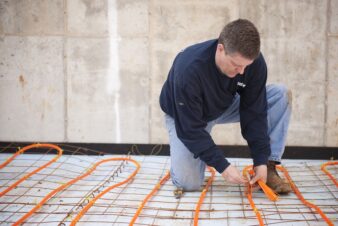Frank Lloyd Wright is unquestionably one of the greatest architects of all times. Experts have said that he was uniquely endowed with supernatural imagination and vision.
Wright is known for his organic, architectural flair and avant-garde designs that use aesthetic elements, complete with cantilevered floors that defy gravity. Among his most famous designs are Falling Water, the Dwight D. Martin House and the Price Tower.
Wright’s Bachman Wilson House was originally built in 1954 along the Millstone River in the National Historic District of the Borough of Millstone, NJ. It was one of his “Usonian” style homes – a distinctly “American” style house that was available and affordable to all, yet with an open floor plan, integrated with nature.
Wright designed Usonian homes to be built with only four different tradesmen: a plumber, an electrician, a mason and a carpenter. He brought the Bachman Wilson House to life with only cement block, concrete, glass and mahogany.
An architect/designer team – Lawrence and Sharon Tarantino – purchased the house in 1988. They restored it meticulously. The Hillsborough Township, NJ-based Tarantino Architect has led the restoration of numerous other Frank Lloyd Wright houses.
In August of 2011, Hurricane Irene hit the Northeast like a runaway freight train. The Millstone River flooded the Tarantino property, sending six feet of river water through the building, resulting in extensive damage to the home. In order for the Bachman Wilson House to live on as a historic monument, it had to be moved.
The Tarantinos decided that selling the house to an institution willing and able to relocate it was the best option for its preservation. Following several years of research for a potential buyer, they sold the home, (complete with all furnishings and interior fixtures) to Crystal Bridges Museum in 2013, who would turn it into a year-round, historical exhibit.
In April of 2014, Wright’s masterpiece was carefully disassembled, board-by-board. Each section was laboriously inventoried, labeled and wrapped for transit. J.B. Hunt Transport, Inc. charitably donated its services, transporting the house to Arkansas at no cost to Crystal Bridges.
Two giant shipping containers were carefully loaded with the dismantled house. One container made the entire 1,235-mile trek via tractor-trailer (taking over 24 hours), while the other was an intermodal transit, using both rail and road.
The construction team that the museum put together is now in the throes of piecing the house back together on site at Crystal Bridges’ 120-acre property in the Northwestern corner of Arkansas.
Director of Operations, Scott Eccleston, estimated that it would take a year to fully reassemble and finish the house.
The home’s front façade, with concrete block and mahogany trim, has a nearly fortress-like appearance that ensured privacy from the street in its original suburban location. Inside, 14-foot-tall, floor-to-ceiling plate glass windows tower over the open floor plan with red concrete floors, imprinted to show the grid work pattern that Frank Lloyd Wright used to design his homes– another architectural facet Wright loved to incorporate.
Even though Wright designed the home in 1954, it was wildly futuristic at the time. Aside from modern aesthetic characteristics, the Bachman Wilson House is equipped with green building components, such as passive solar through abundant use of natural light, and in-floor hydronic radiant heat.
An exacting rebuild
The museum team is using the same methods Frank Lloyd Wright used in the original design for the reconstruction process – even down to using the same nail and screw holes.
The only exception was not an alteration – it was an addition. A basement area was added to the new design so that a mechanical room could be installed out-of-sight for museumgoers. Metal decking fastened to steel joists was chosen to support the concrete floor.
Wright was one of the very first architects to use hydronic radiant heat as a key to clean, uncluttered design, chiefly because it eliminated visible heating elements such as ducts and a variety of terminal units. And while the original hydronic system used copper piping, the museum knowingly avoided that because of the frailty of copper when embedded in concrete. PEX tubing was chosen to transport heated fluids in the floors.
Using a grid system to build the Bachman Wilson House, Wright cast the grid lines right into the concrete – creating blocks that measure four-foot by four-foot. The grid lines (lettered horizontally and numbered vertically), show where all the homes’ major elements align, so that when it was built (and now being rebuilt) workers knew, for example, that the fireplace would start exactly on grid D13 and end on E13.
 “Every element in the home is on the grid or half-grid,” explained Bill Faber, president of Bentonville, AR-based Bill Faber Construction, the general contractor. “Reconstructing a house that’s been built and disassembled once before is like a jigsaw puzzle. We’re using the original boards and material to rebuild it, so everything has to piece together perfectly – including the new concrete floors – down to less than a sixteenth of an inch.”
“Every element in the home is on the grid or half-grid,” explained Bill Faber, president of Bentonville, AR-based Bill Faber Construction, the general contractor. “Reconstructing a house that’s been built and disassembled once before is like a jigsaw puzzle. We’re using the original boards and material to rebuild it, so everything has to piece together perfectly – including the new concrete floors – down to less than a sixteenth of an inch.”
So that workers could make exact grooves to match the original grid work in the concrete without having to reach too far with the groove-making tool – potentially causing mistakes or damage – the concrete had to be poured in alternating eight-foot wide by 20-foot long strips.
Workers first installed Watts RadiantPEX+ tubing in alternating sections, with terminations in the basement below, leaving other sections untouched so that they could work in the areas without causing damage.
“Another tricky piece to the puzzle was the patio in front, and to the side of the Bachman Wilson House,” said Faber. “Because of year-round visitors from the museum, Crystal Bridges needed to ensure a safe and dry environment in the occasion of snow.”
Snowmelt, too
“The patio was heated with radiant snowmelt. Wright designed the home so that the entire structure – patio and all – would have one big concrete slab foundation,” said Cary Pestel, owner of Tulsa, OK-based Boone & Boone Sales, the manufacturers representative firm for the job.
 To accommodate those plans, the 1,400 s.f. patio was included in the sections to be poured. The interior sections of radiant will have a steady 126°F flow of water going through it. The patio is warmed with a 50% glycol/water mix running at a constant 136°F.
To accommodate those plans, the 1,400 s.f. patio was included in the sections to be poured. The interior sections of radiant will have a steady 126°F flow of water going through it. The patio is warmed with a 50% glycol/water mix running at a constant 136°F.
“The sectioned radiant installation and concrete pour also ensured that if there was ever damage to one section of the floor throughout the whole rebuilding process, only that section would need to be repaired, instead of having to jackhammer the whole thing and start over again,” explained Pestel.
Ripley’s Believe it or Not Home Decor
The Bachman Wilson House was designed with a second story – which is rare for a Wright home. Adding to the oddity are the home’s original, built-in mahogany beds, which appear to grow out of the mahogany flooring. Conventional forced air heating and cooling is delivered to the two bedrooms and a bathroom up there. The air moves through hidden vents – some visible only by close inspection under abandoned, but still standing radiators (vestiges of the original heating system), or tucked within the bedframes.
A basement mechanical room is now the main area of operations for all things mechanical and hydronic. A modulating 104 to 285 MBH Viessmann Vitodens boiler will provide for all radiant heating and snowmelt.
To conserve space and on-site mechanical fabrication time, Pestel specified the installation of three Watts Radiant Hydronex panels. The preassembled, pre-engineered hydronic control panels include a PM-4-PO primary panel, a DD-2-2 direct panel for distribution to the snow-melted surfaces, and a D-Mix, DM-2-2 for the inside floors.
“We’ll use the tekmar 664 snow-melt control with their outdoor slab sensor to control the snow-melt,” said Pestel. “Also, we’ll use the Tek519 thermostats for the inside zones. These will be mounted in the basement so they won’t be seen on the walls upstairs. They weren’t available in Frank Lloyd Wright’s times, so we are hiding them.
“Additionally, we’ll use in-slab sensors for the concrete floors, with wiring that’s run into sleeves that were installed under the slab prior to pouring the floors,” he said.
Humidity challenges
Arkansas summers can reach highs in excess of 100°F, with sweltering humidity. Winter temperatures can dip into the negatives, all while holding that same humidity level. To reduce the possibility of sweating, thin vents in the concrete floor below the authentic single-pane glass walls and windows will constantly bathe the windows in dry air
“Because this area is so humid, we also installed a whole-house dehumidifier system in the basement,” said Jeff Handley, owner of Seligman, MO-based Handley Heating. “An open plenum return pulls air from several different locations in the house to the basement, where it is dehumidified before being introduced back into the HVAC system.”
Masterpiece restored
“For everyone involved in the process of rebuilding the Bachman Wilson House, it was a job unlike any before it. Disassembly, relocation and reconstruction of a historical masterpiece – saving it from what otherwise would have been its certain demise – was an amazing feat,” said Eccleston.
The Bachman Wilson House is now open to Frank Lloyd Wright devotees and museumgoers. Crystal Bridges Museum draws more than 500,000 visitors a year. People from all over the country schedule trips to Bentonville just to see the house.




Join the conversation: